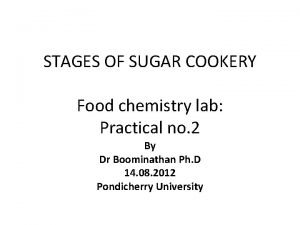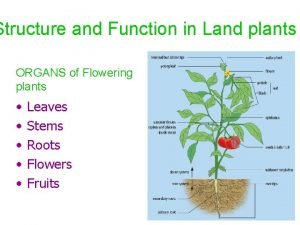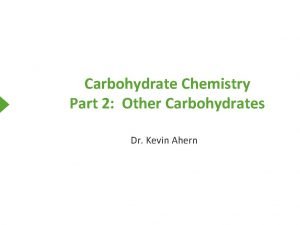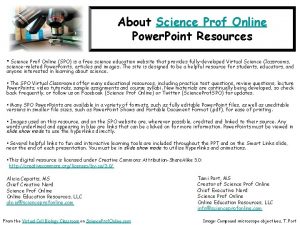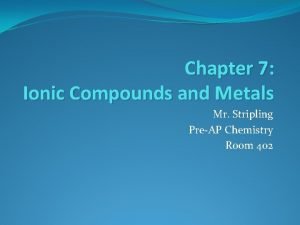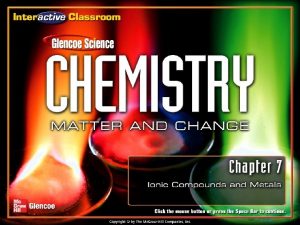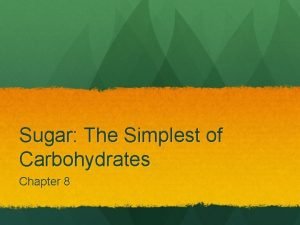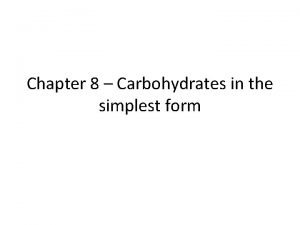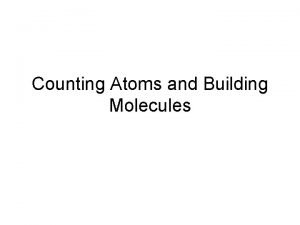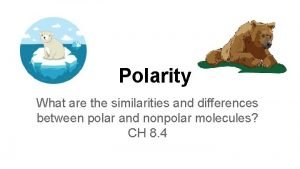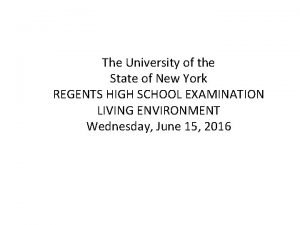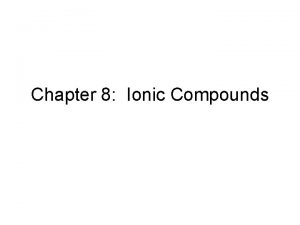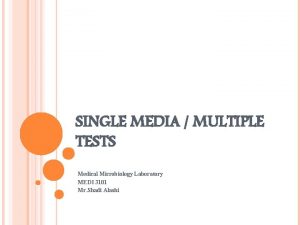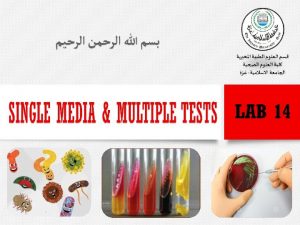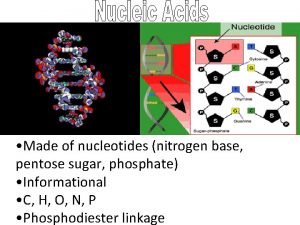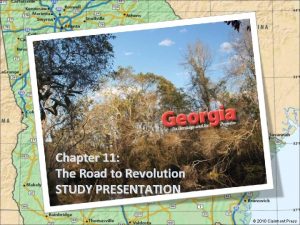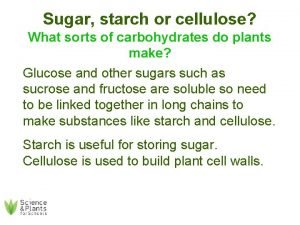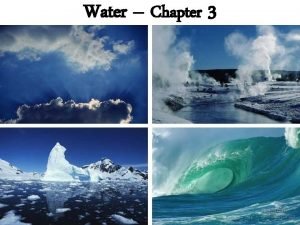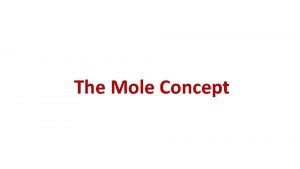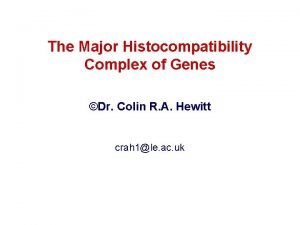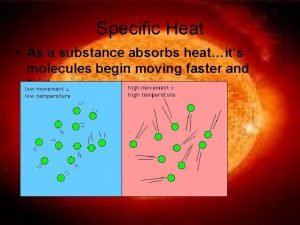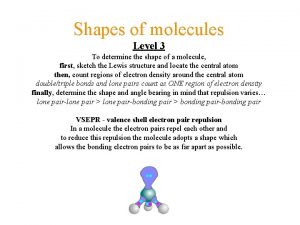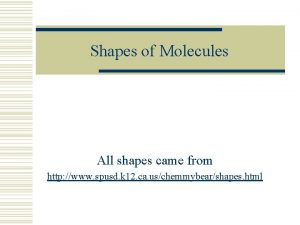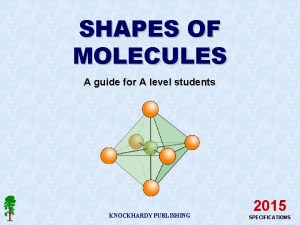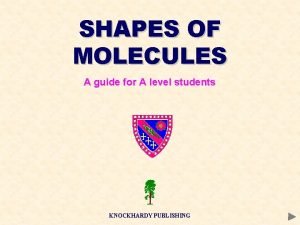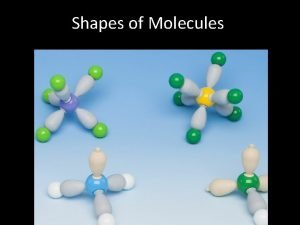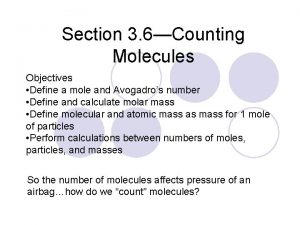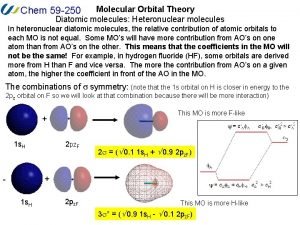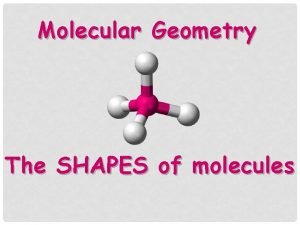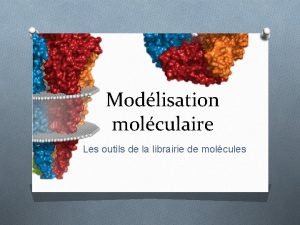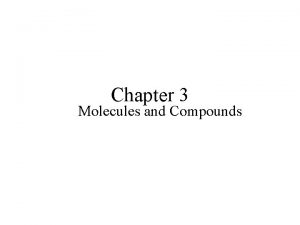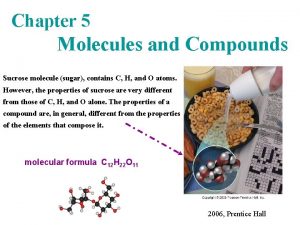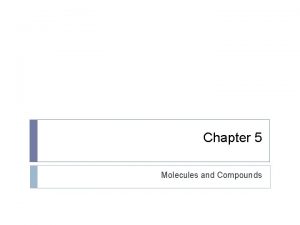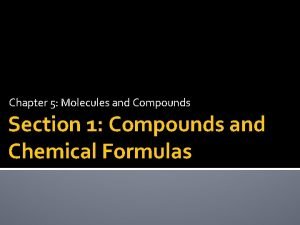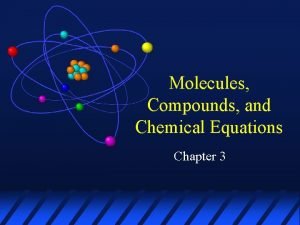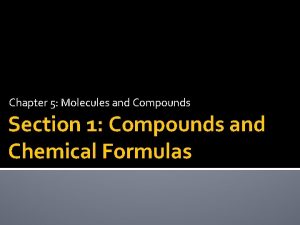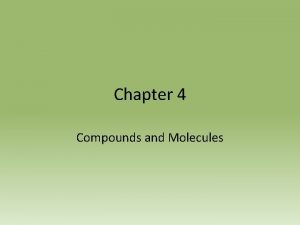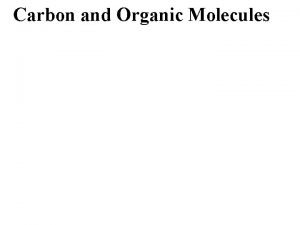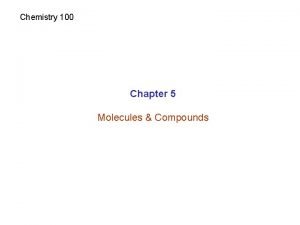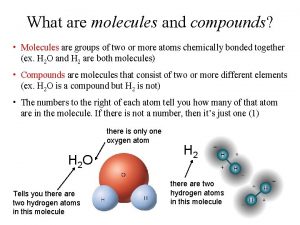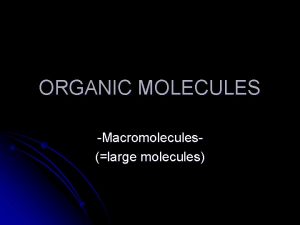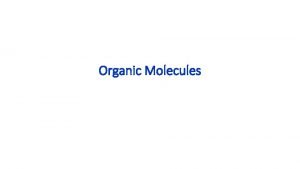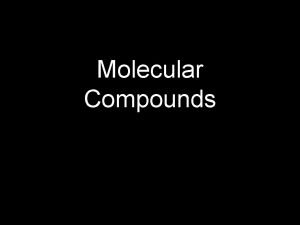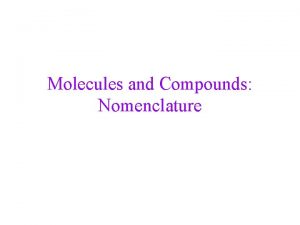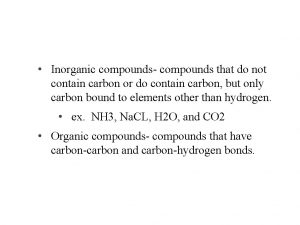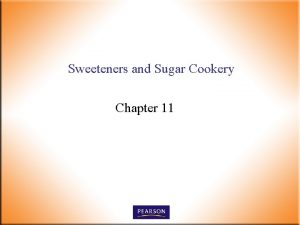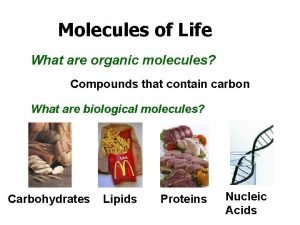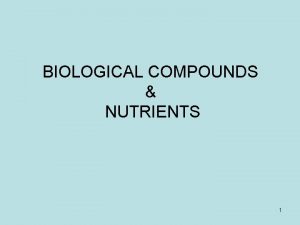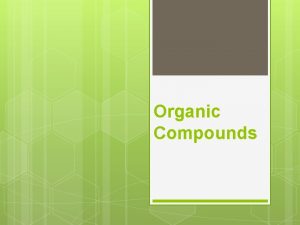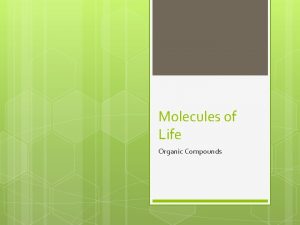Chapter 5 Molecules and Compounds 5 1 Sugar

































































- Slides: 65

Chapter 5 Molecules and Compounds

5. 1 Sugar and Salt � Ordinary table sugar is a compound called sucrose. � A sucrose molecule, such as the one shown here, contains carbon, hydrogen, and oxygen atoms. � The properties of sucrose are very different from those of carbon, shown here in the form of graphite, and hydrogen and oxygen. © 2012 Pearson Education, Inc.

5. 1 Sugar and Salt � FIGURE 5. 1 Elemental sodium Sodium is an extremely reactive metal that dulls almost instantly upon exposure to air. � FIGURE 5. 2 Elemental chlorine Chlorine is a yellow gas with a pungent odor. It is highly reactive and poisonous. © 2012 Pearson Education, Inc.

5. 1 Sugar and Salt � FIGURE 5. 3 Sodium chloride The compound formed by sodium and chlorine is table salt. � The properties of a compound are, in general, different from the properties of the elements that compose it. © 2012 Pearson Education, Inc.

5. 2 Compounds Display Constant Composition �Some of the substances we encounter in everyday life are elements. �Most are not elements—they are compounds. �Free atoms are rare in nature. �A compound is different from a mixture of elements. �In a compound, the elements combine in fixed, definite proportions. �In a mixture, they can have any proportions whatsoever. © 2012 Pearson Education, Inc.

5. 2 Compounds Display Constant Composition FIGURE 5. 4 A mixture This balloon is filled with a mixture of hydrogen and oxygen gas. The relative amounts of hydrogen and oxygen are variable. FIGURE 5. 5 A chemical compound This balloon is filled with water, composed of molecules that have a fixed ratio of hydrogen to oxygen. (Source: Jo. Lynn E. Funk. ) © 2012 Pearson Education, Inc.

5. 2 Compounds Display Constant Composition � Joseph Proust (1754– 1826) formally stated the idea that elements combine in fixed proportions to form compounds. � The law of constant composition states: All samples of a given compound have the same proportions of their constituent elements. © 2012 Pearson Education, Inc.

5. 2 Constant Composition: Mass Ratio � For example, if we decompose an 18. 0 g sample of water, we would get 16. 0 g of oxygen and 2. 0 g of hydrogen, or an oxygen-to-hydrogen mass ratio of � This is true of any sample of pure water, no matter what its origin. © 2012 Pearson Education, Inc.

5. 2 Constant Composition: Mass Ratio �If we decompose a 17. 0 g sample of ammonia, a compound composed of nitrogen and hydrogen, we would get 14. 0 g of nitrogen and 3. 0 g of hydrogen, or a nitrogento-hydrogen mass ratio of �Even though atoms combine in whole-number ratios, their mass ratios are not necessarily whole numbers. © 2012 Pearson Education, Inc.

5. 3 Chemical Formulas: How to Represent Compounds �Compounds have constant composition with respect to mass because they are composed of atoms in fixed ratios. �A chemical formula indicates the elements present in a compound and the relative number of atoms of each. �For example, H 2 O is the chemical formula for water; it indicates that water consists of hydrogen and oxygen atoms in a 2: 1 ratio. �The formula contains the symbol for each element, accompanied by a subscript indicating the number of atoms of that element. By convention, a subscript of 1 is omitted. © 2012 Pearson Education, Inc.

5. 3 Chemical Formulas: How to Represent Compounds Common chemical formulas include: � Na. Cl for table salt, indicating sodium and chlorine atoms in a 1: 1 ratio. �CO 2 for carbon dioxide, indicating carbon and oxygen atoms in a 1: 2 ratio. �C 12 H 22 O 11 for table sugar (sucrose), indicating carbon, hydrogen, and oxygen atoms in a 12: 22: 11 ratio. �The subscripts in a chemical formula represent the relative numbers of each type of atom in a chemical compound; they never change for a given compound. © 2012 Pearson Education, Inc.

5. 3 Chemical Formulas: How to Represent Compounds CO and CO 2 � The subscripts in a chemical formula are part of the compound’s definition—if they change, the formula no longer specifies the same compound. � CO is the chemical formula for carbon monoxide, an air pollutant with adverse health effects on humans. � When inhaled, carbon monoxide interferes with the blood’s ability to carry oxygen, which can be fatal. � CO is the primary substance responsible for deaths of people who inhale too much automobile exhaust. � If you change the subscript of the O in CO from 1 to 2, you get the formula for a totally different compound. � CO 2 is the chemical formula for carbon dioxide, the relatively harmless product of combustion and human respiration. We breathe small amounts of it all the time with no harmful effects. © 2012 Pearson Education, Inc.

5. 3 Chemical Formulas: How to List the Elements in Order in Compounds � Chemical formulas list the most metallic elements first. � The formula for table salt is Na. Cl, not Cl. Na. � In compounds that do not include a metal, the more metal-like element is listed first. � Metals are found on the left side of the periodic table and nonmetals on the upper right side. � Among nonmetals, those to the left in the periodic table are more metal-like than those to the right and are normally listed first. � We write NO 2 and NO, not O 2 N and ON. � Within a single column in the periodic table, elements toward the bottom are more metal-like than elements toward the top. � We write SO 2 not O 2 S. © 2012 Pearson Education, Inc.

5. 3 Chemical Formulas: How to List the Elements in Order in Compounds �The specific order for listing nonmetal elements in a chemical formula is shown in Table 5. 1. �There a few historical exceptions in which the most metallic element is named first, such as the hydroxide ion, which is written as OH−. © 2012 Pearson Education, Inc.

Example 5. 2 Writing Chemical Formulas Write a chemical formula for each compound. (a) the compound containing two aluminum atoms to every three oxygen atoms (b) the compound containing three oxygen atoms to every sulfur atom (c) the compound containing four chlorine atoms to every carbon atom SOLUTION Since aluminum is the metal, it is listed first. (a) Al 2 O 3 Since sulfur is below oxygen on the periodic table and since it occurs before oxygen in Table 5. 1, it is listed first. (b) SO 3 (c) CCl 4 Since carbon is to the left of chlorine on the periodic table and since it occurs before chlorine in Table 5. 1, it is listed first.

5. 3 Chemical Formulas: How to Represent Compounds with Polyatomic Ions � Some chemical formulas contain groups of atoms that act as a unit. � When several groups of the same kind are present, their formula is set off in parentheses with a subscript to indicate the number of that group. � Many of these groups of atoms have a charge associated with them and are called polyatomic ions. � To determine the total number of each type of atom in a compound containing a group within parentheses, multiply the subscript outside the parentheses by the subscript for each atom inside the parentheses. © 2012 Pearson Education, Inc.

Total Number of Each Type of Atom in a Chemical Formula � Determine the number of each type of atom in Mg(NO 3)2. � Mg(NO 3)2 indicates a compound containing one magnesium atom (present as the Mg 2+ ion) and two NO 3− groups. Mg: N: O: 1 = 1 Mg 1 × 2 3 × 2 = 2 N = 6 O © 2012 Pearson Education, Inc.

Types of Chemical Formulas � An empirical formula gives the relative number of atoms of each element in a compound. � A molecular formula gives the actual number of atoms of each element in a molecule of the compound. � For example, the molecular formula for hydrogen peroxide is H 2 O 2, and its empirical formula is HO. � The molecular formula is always a whole number multiple of the empirical formula. � For many compounds, such as H 2 O, the molecular formula is the same as the empirical formula. � A structural formula uses lines to represent chemical bonds and shows how the atoms in a molecule are connected to each other. © 2012 Pearson Education, Inc.

Types of Chemical Formulas � Molecular models—three-dimensional representations of molecules—are used to represent compounds. � We use two types of molecular models: balland-stick and space-filling. � In ball-and-stick models, we represent atoms as balls and chemical bonds as sticks. � The balls and sticks are connected to represent the molecule’s shape. The balls are color coded, and each element is assigned a color as shown in the margin. � In space-filing models, atoms fill the space between each other to more closely represent our best idea for how a molecule might appear if we could scale it to a visible size. © 2012 Pearson Education, Inc.

Comparison of Formulas and Models for Methane, CH 4 � The molecular formula of methane indicates that methane has 1 carbon atom and 4 hydrogen atoms. � The structural formula shows how the atoms are connected: each hydrogen atom is bonded to the central carbon atom. � The ball-and-stick model and the space-filling model illustrate the geometry of the molecule: how the atoms are arranged in three dimensions. © 2012 Pearson Education, Inc.

© 2012 Pearson Education, Inc.

Elements may be atomic or molecular. � Atomic elements are those that exist in nature with single atoms as their basic units. Most elements fall into this category. � Molecular elements do not normally exist in nature with single atoms as their basic units. Instead, these elements exist as diatomic molecules—two atoms of that element bonded together—as their basic units. © 2012 Pearson Education, Inc.

Elements may be atomic or molecular. The basic units that compose mercury, an atomic element and a metal, are single mercury atoms. The basic units that compose chlorine, a molecular element, are diatomic chlorine molecules, each composed of two chlorine atoms. © 2012 Pearson Education, Inc.

Elements that exist as diatomic molecules are shown in Table 5. 2. © 2012 Pearson Education, Inc.


Compounds may be molecular or ionic. � Molecular compounds are compounds formed from two or more nonmetals. The basic units of molecular compounds are molecules composed of the constituent atoms. � Ionic compounds contain one or more cations paired with one or more anions. © 2012 Pearson Education, Inc.

Compounds may be molecular or ionic. The basic units that compose dry ice, a molecular compound, are CO 2 molecules. The basic units that compose table salt, an ionic compound, are Na. Cl formula units. © 2012 Pearson Education, Inc.

Ionic Compounds � When a metal, which has a tendency to lose electrons, combines with a nonmetal, which has a tendency to gain electrons, one or more electrons transfer from the metal to the nonmetal, creating positive and negative ions that are attracted to each other. � A compound composed of a metal and a nonmetal is considered ionic. � The basic unit of ionic compounds is the formula unit. � Unlike molecular compounds, ionic compounds do not contain individual molecules but rather cations and anions in an alternating three-dimensional array. © 2012 Pearson Education, Inc.

Example 5. 4 Classifying Substances as Atomic Elements, Molecular Compounds, or Ionic Compounds Classify each substance as an atomic element, molecular compound, or ionic compound. (a) (b) (c) (d) (e) krypton Co. Cl 2 nitrogen SO 2 KNO 3 SOLUTION (a) (b) Krypton is an element that is not listed as diatomic in Table 5. 2; therefore, it is an atomic element. Co. Cl 2 is a compound composed of a metal (left side of periodic table) and nonmetal (right side of the periodic table); therefore, it is (c) (d) (e) an ionic compound. Nitrogen is an element that is listed as diatomic in Table 5. 2; therefore, it is a molecular element. SO 2 is a compound composed of two nonmetals; therefore, it is a molecular compound. KNO 3 is a compound composed of a metal and two nonmetals; therefore, it is an ionic compound.

5. 5 Writing Formulas for Ionic Compounds � Review the elements that form ions with a predictable charge. � Ionic compounds always contain positive and negative ions. � In the chemical formula, the sum of the charges of the positive ions (cations) must always equal the sum of the charges of the negative ions (anions). © 2012 Pearson Education, Inc.

5. 5 Writing Formulas for Ionic Compounds 1. Write the symbol for the metal and its charge followed by the symbol of the nonmetal and its charge. 2. Make the magnitude of the charge on each ion (without the sign) become the subscript for the other ion. 3. If possible, reduce the subscripts to give a ratio with the smallest whole numbers. 4. Check to make sure that the sum of the charges of the cations exactly cancels the sum of the charges of the anions. © 2012 Pearson Education, Inc.

Write a formula for the ionic compound that forms from magnesium and oxygen. Mg. O © 2012 Pearson Education, Inc.

Example 5. 7 Writing Formulas for Ionic Compounds Write a formula for the compound composed of potassium and oxygen. SOLUTION First write the symbol for each ion along with its appropriate charge from its group number in the periodic table. K+ O 2 Then make the magnitude of each ion’s charge become the subscript for the other ion. K+ O 2 becomes K 2 O No reduction of subscripts is necessary in this case. Finally, check to see that the sum of the charges of the cations [2(1+) = 2+] exactly cancels the sum of the charges of the anion (2 ). The correct formula is K 2 O. SKILLBUILDER 5. 7 Writing Formulas for Ionic Compounds Write a formula for the compound that forms from calcium and bromine. Answer: Ca. Br 2 For More Practice Problems 57, 58.

5. 6 Nomenclature: Naming Compounds � Chemists have developed systematic ways to name compounds. � If you learn the naming rules, you can examine a compound’s formula and determine its name, and vice versa. � Many compounds also have a common name. � H 2 O has the common name water and the systematic name dihydrogen monoxide. � Since water is such a familiar compound, everyone uses its common name and not its systematic name. � Common names can be learned only through familiarity; there is no system. © 2012 Pearson Education, Inc.

5. 7 Naming Ionic Compounds � The first step in naming an ionic compound is identifying it as one. � Remember, any time you have a metal and one or more nonmetals together in a chemical formula, you can assume the compound is ionic. © 2012 Pearson Education, Inc.

Ionic compounds can be categorized into two types, depending on the metal in the compound. © 2012 Pearson Education, Inc.

Ionic compounds can be categorized into two types, depending on the metal in the compound. � The first type (called Type I) contains a metal with an invariant charge—one that does not vary from one compound to another. � The second type of ionic compound (called Type II) contains a metal with a charge that can differ in different compounds. � Such metals are usually (but not always) found in the transition metals section of the periodic table. � Some transition metals, such as Zn and Ag, form cations with the same charge in all of their compounds. � Some main group metals, such as Pb and Sn, form more than one type of cation. © 2012 Pearson Education, Inc.

Metals Whose Charge Is Invariant from One Compound to Another © 2012 Pearson Education, Inc.

Some Metals That Form More Than One Type of Ion with Their Common Charges © 2012 Pearson Education, Inc.

Naming Binary Ionic Compounds Containing a Metal That Forms Only One Type of Cation � Binary compounds are those that contain only two different elements. The names for binary ionic compounds containing a metal that forms only one type of ion have the form: � Since the charge of the metal is always the same for these types of compounds, it need not be specified in the compound’s name. © 2012 Pearson Education, Inc.

The base names for various nonmetals and their most common charges in ionic compounds © 2012 Pearson Education, Inc.

Naming Binary Ionic Compounds Containing a Metal That Forms Only One Type of Cation � For example, the name for Na. Cl consists of the name of the cation, sodium, followed by the base name of the anion, chlor, with the ending -ide. � The full name is sodium chloride. Na. Cl sodium chloride © 2012 Pearson Education, Inc.

Naming Binary Ionic Compounds Containing a Metal That Forms More Than One Type of Cation � Since the charge of the metal cation in these types of compounds is not always the same, the charge must be specified in the metal’s name. � We specify the charge with a Roman numeral (in parentheses) following the name of the metal. © 2012 Pearson Education, Inc.

Naming Binary Ionic Compounds Containing a Metal That Forms More Than One Type of Cation � We distinguish between Cu+ and Cu 2+ by writing a (I) to indicate the 1+ ion or a (II) to indicate the 2+ ion: � Cu+ Copper(I) � Cu 2+ Copper(II) © 2012 Pearson Education, Inc.

Naming Binary Ionic Compounds Containing a Metal That Forms More Than One Type of Cation � The full name for these type of compound has the form: © 2012 Pearson Education, Inc.

Determine a charge from the formula of a specific compound. � We can determine the charge of the metal from the chemical formula of the compound. � The sum of all the charges must be zero. � The charge of iron in Fe. Cl 3 must be 3+ in order for the compound to be charge neutral with the three Cl- anions. © 2012 Pearson Education, Inc.

Naming Binary Ionic Compounds Containing a Metal That Forms More Than One Type of Cation The name for the compound Fe. Cl 3 is the name of the cation, iron, followed by the charge of the cation in parentheses (III), followed by the base name of the anion, chlor, with the ending -ide. The full name is iron(III) chloride. Fe. Cl 3 iron(III) chloride © 2012 Pearson Education, Inc.

Naming Ionic Compounds Containing a Polyatomic Ion � Some ionic compounds contain polyatomic ions (ions that are themselves composed of a group of atoms with an overall charge). � Ionic compounds containing polyatomic ions are named using the same procedure we apply to other ionic compounds, except that we use the name of the polyatomic ion whenever it occurs. © 2012 Pearson Education, Inc.

The most common polyatomic ions are listed in Table 5. 6. © 2012 Pearson Education, Inc.

Naming Ionic Compounds Containing a Polyatomic Ion: Oxyanions �Many polyatomic ions are oxyanions, anions containing oxygen. �When a series of oxyanions contain different numbers of oxygen atoms, they are named systematically according to the number of oxygen atoms in the ion. �If there are two ions in the series, the one with more oxygen atoms is given the ending -ate and the one with fewer is given the ending ite. NO 3− NO 2− nitrate nitrite SO 42− SO 32− © 2012 Pearson Education, Inc. sulfate sulfite

Naming Ionic Compounds Containing a Polyatomic Ion � If there are more than two ions in the series, then the prefixes hypo-, meaning “less than, ” and per-, meaning “more than, ” are used. Cl. O − hypochlorite Br. O − hypobromite IO − hypoiodite Cl. O 2− chlorite Br. O 2− bromite IO 2− iodite Cl. O 3− chlorate Br. O 3− bromate IO 3− iodate Cl. O 4− perchlorate Br. O 4− perbromate IO 4− periodate When naming these ions in the homework, be sure to include the word ion in your answer, as in “perchlorate ion. ” © 2012 Pearson Education, Inc.

5. 8 Naming Molecular Compounds � The first step in naming a molecular compound is identifying it as one. � Remember, nearly all molecular compounds form from two or more nonmetals. � We learn how to name binary (two-element) molecular compounds. Their names have the form: © 2012 Pearson Education, Inc.

5. 8 Naming Molecular Compounds When writing the name of a molecular compound, as when writing the formula, the first element is the more metal-like one (see Table 5. 1). The prefixes given to each element indicate the number of atoms present. mono- 1 hexa- 6 di- 2 hepta- 7 tri- 3 octa- 8 tetra- 4 nona-9 penta- 5 deca-10 © 2012 Pearson Education, Inc.

5. 8 Naming Molecular Compounds If there is only one atom of the first element, the prefix mono- is normally omitted. CO 2 mono carbon di- ox -ide The full name is carbon dioxide. The compound N 2 O also called laughing gas, is named according to the first element, nitrogen, with the prefix di-, followed by the base name of the second element, ox, prefixed by mono-, and the suffix -ide. Since mono- ends with a vowel and oxide begins with a vowel, an o is dropped and the two are combined as monoxide. The entire name is dinitrogen monoxide. When the prefix ends with a vowel and the base name starts with a vowel, the first vowel is sometimes dropped, as in monoxide, but not in triiodide. © 2012 Pearson Education, Inc.

5. 9 Naming Acids � Acids are molecular compounds that form ions when dissolved in water. � They are composed of hydrogen, usually written first in their formula, and one or more nonmetals, written second. � We can categorize acids into two groups: binary acids, those containing only hydrogen and a nonmetal, and oxyacids, those containing hydrogen, a nonmetal, and oxygen. © 2012 Pearson Education, Inc.

FIGURE 5. 14 Classification of acids © 2012 Pearson Education, Inc.

Naming Binary Acids � Binary acids are composed of hydrogen and a nonmetal. The names for binary acids have the following form: © 2012 Pearson Education, Inc.

Naming Binary Acids �HCl(aq) is hydrochloric acid. �HBr(aq) is hydrobromic acid. �HCl(g) refers to hydrogen chloride molecules in the gas phase, and not to the acid. �Give the name of H 2 S(aq). �The base name of S is sulfur, so the name is hydrosulfuric acid. © 2012 Pearson Education, Inc.

Naming Oxyacids �Oxyacids are acids that contain oxyanions—found in the table of polyatomic ions. �HNO 3(aq) contains the nitrate NO 3− ion. �H 2 SO 3 (aq) contains the sulfite SO 32− ion. �H 2 SO 4 (aq) contains the sulfate SO 42− ion. �These acids are a combination of one or more H+ ions with an oxyanion. �The number of H+ ions depends on the charge of the oxyanion, so that the formula is always chargeneutral. © 2012 Pearson Education, Inc.

The names of acids containing oxyanions ending with -ite take this form: The names of acids containing oxyanions ending with -ate take this form: © 2012 Pearson Education, Inc.

Table 5. 7 Names of Some Common Oxyacids and Their Oxyanions © 2012 Pearson Education, Inc.

© 2012 Pearson Education, Inc.

EXAMPLE 5. 14 Nomenclature Using the Flowchart © 2012 Pearson Education, Inc.

5. 11 Formula Mass: The Mass of a Molecule or Formula Unit � For any compound, the formula mass is the sum of the atomic masses of all the atoms in its chemical formula: © 2012 Pearson Education, Inc.

Example 5. 29 Calculating Formula Mass Calculate the formula mass of Mg(NO 3)2. SOLUTION Formula mass = 24. 31 amu + 2(14. 01 amu) + 6(16. 00 amu) = 148. 33 amu Calculate the formula mass of Lithium Carbonate.
 Cooking stages
Cooking stages Bial's test reagent
Bial's test reagent Organic molecules vs inorganic molecules
Organic molecules vs inorganic molecules Compound substance
Compound substance Translocation of sugars in plants
Translocation of sugars in plants Is xylem polar or nonpolar
Is xylem polar or nonpolar Reducing vs. non-reducing sugars
Reducing vs. non-reducing sugars All compounds are molecules
All compounds are molecules Oil rig biology
Oil rig biology Venn diagram of ionic covalent and metallic bonds
Venn diagram of ionic covalent and metallic bonds Ionic compounds
Ionic compounds Chemistry chapter 7 ionic and metallic bonding
Chemistry chapter 7 ionic and metallic bonding Chapter 2 atoms molecules and ions
Chapter 2 atoms molecules and ions Chapter 3 molecules of life
Chapter 3 molecules of life Chapter 7 review chemical formulas and chemical compounds
Chapter 7 review chemical formulas and chemical compounds Chapter 7 review modern chemistry answers
Chapter 7 review modern chemistry answers Ionic compounds and metals chapter 7
Ionic compounds and metals chapter 7 Chemistry in biology section 2 chemical reactions
Chemistry in biology section 2 chemical reactions Chapter 7 ionic compounds and metals assessment answer key
Chapter 7 ionic compounds and metals assessment answer key Chapter 6 section 1 atoms elements and compounds
Chapter 6 section 1 atoms elements and compounds Chapter 8 sugar the simplest of carbohydrates
Chapter 8 sugar the simplest of carbohydrates Sugar is the simplest form of
Sugar is the simplest form of Relationship between atoms and molecules
Relationship between atoms and molecules Classify the following unbalanced chemical equations
Classify the following unbalanced chemical equations Solid liquid gas examples
Solid liquid gas examples Chiral achiral
Chiral achiral How can you count atoms and molecules
How can you count atoms and molecules Polar and nonpolar similarities
Polar and nonpolar similarities Atoms molecules and ions
Atoms molecules and ions Atoms molecules and ions
Atoms molecules and ions Atoms molecules and ions
Atoms molecules and ions Atoms molecules and ions
Atoms molecules and ions Atoms ions and molecules
Atoms ions and molecules Atoms ions and molecules
Atoms ions and molecules When a natural disaster destroys a stable ecosystem
When a natural disaster destroys a stable ecosystem Molecular shapes polar or nonpolar
Molecular shapes polar or nonpolar Non polar molecules that include fats oils and cholesterol
Non polar molecules that include fats oils and cholesterol Collision theory states that
Collision theory states that Bead like structures formed by dna and histone molecules
Bead like structures formed by dna and histone molecules Monotomic ion
Monotomic ion Mio test results
Mio test results Lysine iron agar test
Lysine iron agar test Sugar phosphate and nitrogenous base
Sugar phosphate and nitrogenous base Stamp act
Stamp act Sugar and stamp act
Sugar and stamp act Warm sugar solution + yeast and lime water
Warm sugar solution + yeast and lime water Cellulose in iodine test
Cellulose in iodine test Is h2o a polar molecule
Is h2o a polar molecule Avogadro constant symbol
Avogadro constant symbol Mhc molecules
Mhc molecules When a substance absorbs heat its molecules will
When a substance absorbs heat its molecules will Shape of sf2cl +
Shape of sf2cl + Co2 steric number
Co2 steric number Shapes of molecules a level chemistry
Shapes of molecules a level chemistry A level chemistry shapes of molecules
A level chemistry shapes of molecules Chemsheets shapes of molecules
Chemsheets shapes of molecules Molecules to moles
Molecules to moles Heteronuclear diatomic molecules molecular orbital theory
Heteronuclear diatomic molecules molecular orbital theory Axe notation examples
Axe notation examples Mass to moles conversion factor
Mass to moles conversion factor Moles to molecules formula
Moles to molecules formula Librairie de molécules
Librairie de molécules G/mol to mol
G/mol to mol Intermolecular forces in water
Intermolecular forces in water Moles to grams
Moles to grams Atomicity table
Atomicity table
